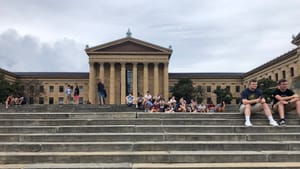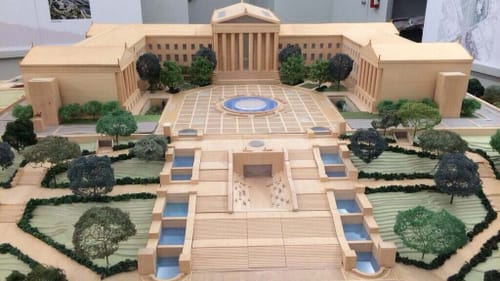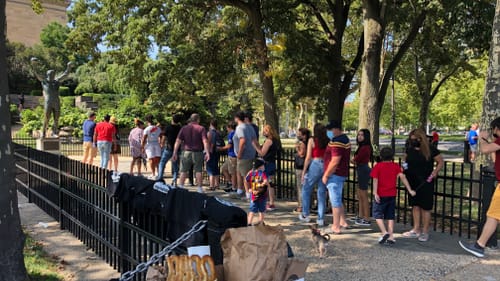Stay in the Loop
BSR publishes on a weekly schedule, with an email newsletter every Wednesday and Thursday morning. There’s no paywall, and subscribing is always free.
The right steps for our public spaces
Who decides on the outside of the Philadelphia Museum of Art?

Philadelphia has long been a city of the people. Just not all the people. From turfing out whole communities to run superhighways through town to tearing down one of the most iconic skateparks in the world to kick the skaters out of Center City, Philly has shown that the powerless have no say. So it comes as little surprise that, as the city considers proposals to turn the Benjamin Franklin Parkway into a people-friendly green space, the Philadelphia Museum of Art is still considering plans to put a hole in its iconic steps as part of architect Frank Gehry’s grand design.
Gehry’s vision for the PMA’s forum and staircases has created a graceful new focal point in the museum’s lower floors, which is more than you can say for the window he proposed for the middle of the steps to the grand East entrance. The model for that looks more like the tomb from a production of Aida than a reflection of the neoclassical temple of art that watches over the city from its hill above the Schuylkill. When the PMA first announced this concept, the response was not positive.
I thought the museum had given up on the idea, but staffers told me recently that it’s still on the table. In August, a spokesperson confirmed in an email that while the design selection process is not confirmed and no construction is scheduled, the window in the stairs continues to be “one design under consideration for a future phase of the Facilities Master Plan.” If it were to move forward, this would make the change an ongoing project during the re-visioning of the Parkway itself.
Planning or the people?
As the city chooses its plans for the Parkway, it is a good time to ask the question: can a place itself—the creation of a team of architects and landscape designers—be considered art? And who gets to answer that question?
On a recent hot Sunday afternoon in front of the PMA, people were out in numbers. Seven busy ice cream trucks surrounded the main building. Street vendors hawked soft pretzels and water bottles. T-shirts with the Rocky statue printed on them draped the fence that separates Rocky Balboa, triumphant in bronze, from the serious business of museuming. Visitors ran up the steps or waited in long lines for selfies with Rocky to the right of the stairway.
I could hear people calling them “the Rocky steps.” I cringed a little, but nobody on that sunny afternoon wanted to hear that the steps were iconic before Sylvester Stallone was born. The public had spoken, imbuing the monument to art with their own meaning, and not I nor the board of directors of the PMA can change that, though the latter may still try.
Uneasy divides
Attitudes about the steps haven’t changed much since the Gehry plans were announced in 2014: museum members who live in the neighborhood express the most enthusiasm, marking an uneasy divide between the people who access the galleries and the people who come to the grounds. The inside audiences take a proprietary view of the art within the museum walls, and the outside audiences are having their own, very different experience—an experience that needs to be taken into account if and when plans for the area move ahead.

Right now, the Parkway is still one of the most beautiful streets in the world. Lovely arcades of trees separate lanes of traffic while leading people on foot from Love Park to the PMA. But if you don’t know where you’re walking, as was the case for a young couple with a baby stroller I saw that Sunday, you can find yourself stranded on a lonely spit of concrete with no safe way to reach Eakins Oval, which must be crossed before you brave the traffic that pours in off the highways and swings past the museum at speed. We need a safe way to separate bikers and pedestrians from the cars and from each other, but we also need the city to have some respect for the use that the people on the outside make of the outdoor space.
The problem is, and has always been, that the city has seen the Parkway and the space around the museum as the province of the inside people, those who go into the museums. It has been far less concerned with the people who come to walk the Parkway, who wander the grounds of the PMA because they are beautiful in themselves, and just as important, because people have imbued that exterior with meaning outside the one the institution prefers. People from all over the world come for the steps and a picture at the Rocky Statue. From San Francisco and Paraguay, from Cleveland and Bolivia, talking in half a dozen languages, they are drawn to this spot because the statue and the building have meaning for them.
I’ve always found it curious that an institution that enshrines a urinal in its galleries because of its history in an antiestablishment art movement seems to disdain a piece of monumental art by a working sculptor because its fame is from a popular film. It sort of makes Duchamp’s point.

More than amenities
The city owns the buildings and grounds of the PMA, and ultimately the city will decide what it really means to build a space for the outside people. Bathrooms would be nice. They come with the price of a ticket for inside people, but if you need to pee and you don’t have the fee, you have to hold it until you get to Lloyd Hall at Boathouse Row (about a half-mile walk from the steps), and then hope it isn’t locked.
But it isn’t just the amenities that say the families picnicking on the lawn belong here. We need to respect the fact that the Philadelphia Museum of Art is itself the best kind of art, the multivalent kind, cherished by different people for different reasons, from 13th-century stonework to Impressionist paintings to a 1976 film. Moving forward with Gehry’s cut-out vision for the east steps, the part of the building that is most beloved by the outside people, would ride roughshod over the meaning those people have given to their public space.
Sign up for our newsletter
All of the week's new articles, all in one place. Sign up for the free weekly BSR newsletters, and don't miss a conversation.

 Camille Bacon-Smith
Camille Bacon-Smith